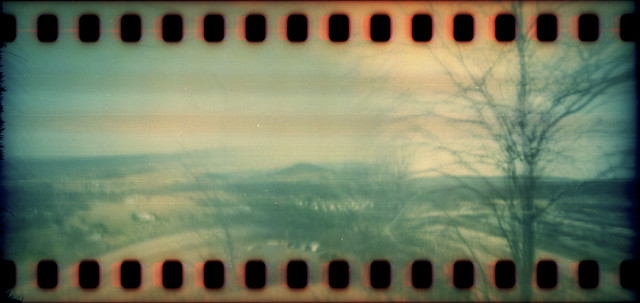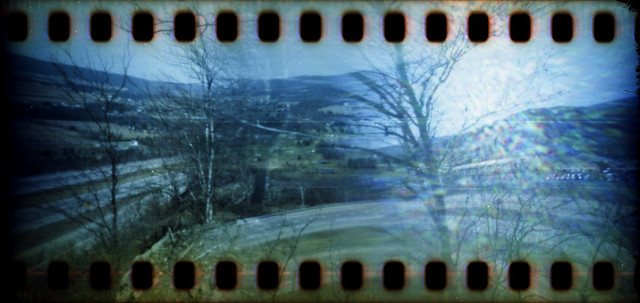Forums › Forums › Get Technical › Hardware › Mr. Peanut
- This topic has 12 replies, 7 voices, and was last updated 15 years ago by
 orionid.
orionid.
-
AuthorPosts
-
September 21, 2010 at 3:34 am #2039
 orionidParticipant
orionidParticipantThis is actually an old project that I just got the film developed from.



Things I forgot to annotate in the photos:
1) The soda can aluminum pieces that host the actual pinholes are taped to the inside of the can with black gaffers tape.2) The inside of the can is lined with black foam rubber – top, bottom, and sides – to prevent reflections from the silver can insides and light leak from the flimsy plastic lid.
3) Black canister was used to prevent illumination of a clear canister ruining the image.
I’ve only ran one roll through it, and the developer was kind enough to accidentally push-process it because it got stuck in the machine. Fortunately, I was bracketing to attempt to calculate actual f/ values, so there were still usable shots.
September 23, 2010 at 3:59 am #33226LeicaLens
ParticipantYou’re the MacGyver of Farktography!
Interesting effect it produces. Is there a light leak on the right, or is it a flare?
Very cool, anyway.
September 23, 2010 at 1:44 pm #33227 orionidParticipant
orionidParticipantThanks. I think the flare-like-ness on the right comes from having a slightly larger pinhole and using the same exposure time.
September 23, 2010 at 1:52 pm #33228ravnostic
ParticipantYou’re the MacGyver of Farktography!
Yeah, that. Regarding the pinholes, did you ‘buff’ them to remove the pointy parts?
Are you aware that you can buy sewing needles in a variety of sizes for suitable aperture goodness (which you’d have to experiment with, but experimentation doesn’t seem to be your weak suit)?
Where did I read that thin brass makes a nice pinhole camera material, and that you can get it cheap at home depot–perhaps you?
I’ll say it again. You’re Batman.
I gotta start doing things like this. Seems like loads of fun.
September 23, 2010 at 4:32 pm #33229chupathingie
Participantooooohhhh… this got the gears spinning for me… then I found out (like most neat ideas) that someone had already done what popped into my head…
http://www.galerie-photo.com/roto-pinhole.html
Still looks like a fun project, if a bit involved…September 23, 2010 at 7:13 pm #33230 orionidParticipant
orionidParticipant@ chupathingie – Yes.
I have spent a good deal of time at that site and have already sketched out plans for both my own version of his device as well as a similar one that will use Nikon F mounts so that I can change focal length and other characteristics.
Yeah, that. Regarding the pinholes, did you ‘buff’ them to remove the pointy parts?
Sort of. I sanded both sides with #600 and #1200 grit wet/dry sandpaper.
Are you aware that you can buy sewing needles in a variety of sizes for suitable aperture goodness (which you’d have to experiment with, but experimentation doesn’t seem to be your weak suit)?
Quite. But I used a sharpened thumbtack for these because it was easier to control.
Where did I read that thin brass makes a nice pinhole camera material, and that you can get it cheap at home depot–perhaps you?
Maybe, I have heard/read that, too. I didn’t see the thin-sheet brass at the hardware store, but Michael’s and AC Moore have brass foil that is quite thin, and should work for extremely tiny pinholes. Thing, is, though, there’s actually an optimum pinhole diameter for a given focal length, and short of super-wide angles, something that tiny/precise just isn’t necessary.
Resource: http://www.mrpinhole.com/
October 11, 2010 at 12:24 am #33231JoeMarfice
ParticipantJust to ease the work a little, the ideal pinhole size is given by
PINHOLE DIAMETER = 1.9 * sqrt( f * wavelength)
which, for a film plan f mm from the pinhole, works out to be 0.044*sqrt(f) mm wide. With f expressed in inches, that’s 0.088*sqrt(f) inches. (A normal inches-to-mm conversion factor of 25.4 doesn’t work, because of the square root.)(source: http://en.wikipedia.org/wiki/Pinhole_camera)
BTW, it’s really important to use a very thin pinhole material, at least near the pinhole itself. The wall thickness of the pinhole will contribute strongly to vignetting of off-axis rays. Be sure to sand/polish the material down to a minimum at the pinhole, if using brass shims or something similar.[/i]
October 11, 2010 at 3:27 am #33232Curious
Participanti was told there would be no math.
October 11, 2010 at 4:48 am #33233JoeMarfice
ParticipantYou were lied to.
Again.
October 11, 2010 at 1:19 pm #33234Curious
Participantwelcome JoeMarfice, are you a pinhole enthusiast?
October 11, 2010 at 4:11 pm #33235JoeMarfice
ParticipantI’m an optical engineer professionally, so, yeah, I guess I am!
October 12, 2010 at 2:08 am #33236bucky_bacon
ParticipantAwesome! I just learned a new way to make a spy cam! Thanks guy!
October 12, 2010 at 3:13 am #33237 orionidParticipant
orionidParticipantThanks for the tips. I usually go to this place to knock out the math, though.
-
AuthorPosts
- The topic ‘Mr. Peanut’ is closed to new replies.


